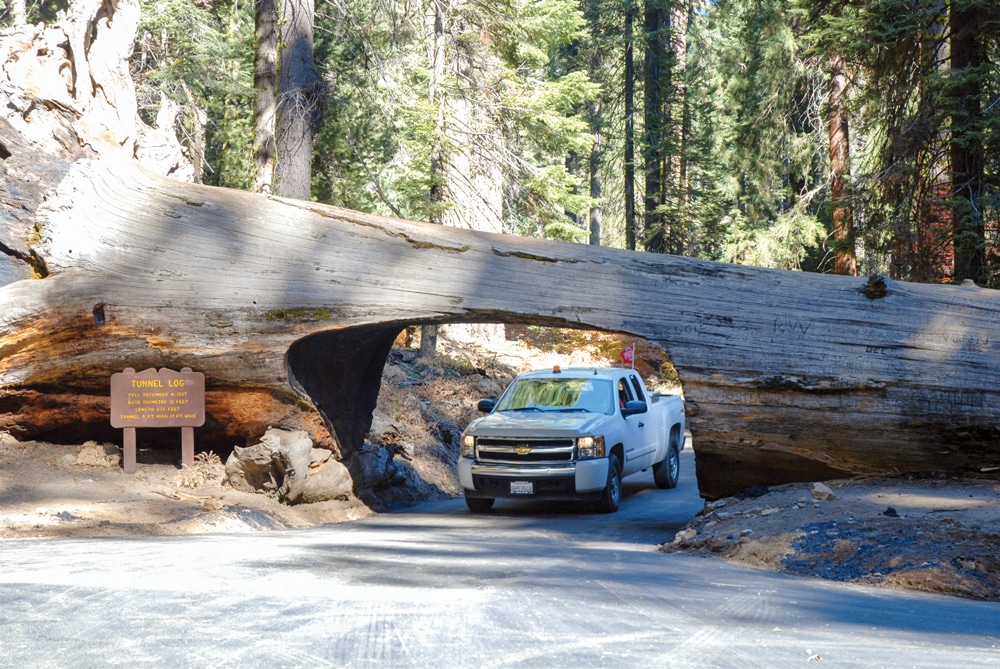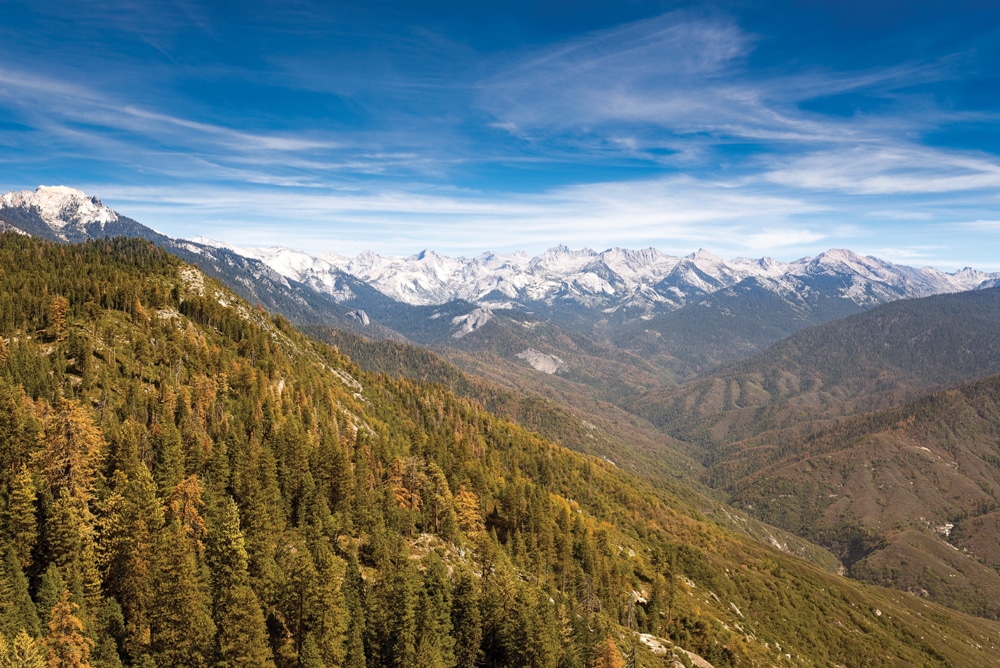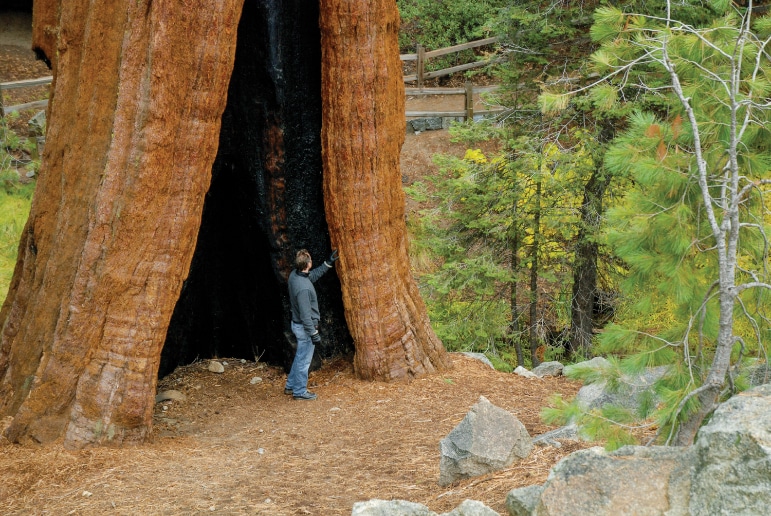A trip through Sequoia and Kings Canyon National Parks will introduce you to a forest on a scale you can scarcely imagine
When was the last time you looked at a tree with a true sense of wonder? If you can’t remember, perhaps it’s time you paid a visit to the awe-inspiring Sequoia and Kings Canyon National Parks.
 That’s because one of these parks, located in central California’s Sierra Nevada, is home to a colossus of the tree world. Namely, the 275-foot-tall General Sherman (in Sequoia National Park), a giant redwood that’s considered to be the world’s largest tree by volume, calculated at a mind-boggling 52,500 cubic feet.
That’s because one of these parks, located in central California’s Sierra Nevada, is home to a colossus of the tree world. Namely, the 275-foot-tall General Sherman (in Sequoia National Park), a giant redwood that’s considered to be the world’s largest tree by volume, calculated at a mind-boggling 52,500 cubic feet.
But while these supersize sequoias, found in both parks, may be the marquee attractions, they’re far from the only reason you’ll want to visit these parks.

he opening in the Tunnel Log is 8 feet tall. The log can be found along Crescent Meadow Road in Giant Forest.
Largest, Deepest, Highest
 If there was a single word that sums up Sequoia and Kings Canyon National Parks it might be “ginormous.” Not a technical term, mind you, but it seems somehow fitting for a place that’s home to not only the world’s largest tree, but to a valley deeper than the Grand Canyon and the highest mountain in the Lower 48.
If there was a single word that sums up Sequoia and Kings Canyon National Parks it might be “ginormous.” Not a technical term, mind you, but it seems somehow fitting for a place that’s home to not only the world’s largest tree, but to a valley deeper than the Grand Canyon and the highest mountain in the Lower 48.
To plan your visit, it helps to know that Sequoia and Kings Canyon, with a total of 1,353 square miles, are actually two different contiguous parks that fit together like puzzle pieces. They are administered as a single unit, however, which explains why we – and the National Park Service itself, for that matter – often refer to them by just the one name.
“God of the Woods”
Renowned naturalist John Muir called the giant sequoia the “God of the Woods.” One look and we think you’ll understand what he meant.

Climbing the 400 steps fitted into Sequoia’s Moro Rock rewards visitors with a panoramic view of the High Sierra and the surrounding canyons.
Once found throughout the Northern Hemisphere, today the last of the giant sequoias live in roughly 75 groves on the western slopes of the Sierra Nevada. Combine their long lifespans – as long as 3,000 years – with their fast growth rates, and you have a recipe for the world’s most massive trees.

Getting There
Two highways enter the parks. State Highway 180 from Fresno leads to Kings Canyon National Park, then continues 30 miles east to Cedar Grove. State Highway 198 enters Sequoia National Park from the southwest via Three Rivers. Inside the parks, Highway 198 becomes the Generals Highway and connects to Highway 180. In winter, the Generals Highway between the parks often closes.
The sequoia’s longevity can be attributed to its natural defenses, including bark up to 3 feet thick that provides protection from wildfires and insects. The sequoia’s main threat, however, has long been man himself. Loggers targeted these groves in the late 1800s until – in a fortuitous twist of fate – they realized the trees weren’t commercially viable, as they tended to shatter upon impact with the ground.
Walk Among Giants
If you’re like most people, the first thing you’ll want to do is see some big trees. Following are some of the best places to do just that.
In Sequoia National Park you’ll want to visit the 1,880-acre grove John Muir named the Giant Forest. There are roughly 8,000 sequoias here, including the General Sherman tree and four more of the planet’s 10 biggest. Best of all, they’re easily accessible thanks to 40 miles of walking trails that wind through this grove alone. Note that the section of the Generals Highway leading to and from the Big Trees in Giant Forest was built in 1926, and the road was not constructed to accommodate long vehicles, so leave the motorhome in camp and take your dinghy.
Kings Canyon has 154-acre Grant Grove, home to another of the world’s largest trees, the 268-foot General Grant. Also here is Tharp’s Log, a fallen sequoia that was used as an impromptu cabin by former miner and would-be cattle rancher Hale Tharp, one of the earliest white men to enter the area.
While you’re in the neighborhood, be sure to take a stroll on the 2-mile Big Stump Trail. Here you’ll get a feel for the huge trees that were lost to logging, and what it must have been like for the lumberjacks who felled them using nothing more than a double-sided axe and a very large cross-cut saw.
To touch a remarkable remnant of this period, head for the heavily logged Converse Basin to check out the Chicago Stump, all that’s left of a giant sequoia that was chopped down, sawed up and shipped to Chicago, where it was reassembled for the 1893 World Columbian Exhibition. Also, where it was promptly declared a hoax because no one could believe there could actually be trees that large.
Sequoia Must-Sees
As we said at the outset, Sequoia and Kings Canyon have much more to offer than just the big trees that, quite literally, put them on the map.
For one of Sequoia National Park’s most old-fashioned attractions, start your visit with a photo op at the rightly famous Tunnel Log. After all, it’s not every day you get to drive underneath a 275-foot sequoia like the one that fell across Crescent Meadow Road back in 1937. You’ll need your dinghy for this part of the journey: Vehicles longer than 22 feet are prohibited during shuttle season (May through Labor Day weekend).
Just up the road from Tunnel Log is the equally noteworthy Moro Rock, a granite dome that offers sweeping views of much of the park. Hardy hikers can access those views by way of a half-mile trail that includes a 400-step stairway built in 1931 by the Civilian Conservation Corps.
To get another perspective on Sequoia National Park, try looking at it from the bottom up on a trip through Crystal Cave. These caverns are home to elaborately decorated rooms full of stalactites, stalagmites, flowstone and more (this is a popular attraction, so it’s best to purchase your tickets online ahead of time at www.recreation.gov). Crystal Cave is generally open from May through late November, weather permitting, but vehicles longer than 22 feet are prohibited on Crystal Cave Road.
Finally, don’t miss the impressive Tokopah Falls, located at the end of a 1.7-mile hike along a fork of the Kaweah River. Although this waterfall is actually 1,200 feet high, it descends in a series of shorter, frothy cascades that enhance its beauty.
Kings Canyon: End of the Road
If you looked at a map and got the impression you could motor through both Sequoia and Kings Canyon in just one day, you may want to rethink your plan. While it may be possible, it’s not recommended, as Kings Canyon National Park is worth taking a full day to explore all by itself.
The classic drive into this less crowded part of the park follows state Highway 180, better known in this area as the Kings Canyon Scenic Byway, that winds its way 50 miles to the spot simply known as Road’s End.
Along the way it passes several waterfalls, including the thundering 75-foot drop of Grizzly Falls, en route to the Cedar Grove Visitor Center, where you’ll find it hard to miss the steep-walled valley’s resemblance to nearby Yosemite National Park.
At Road’s End will be the trailhead for Mist Falls, a 100-foot cascade that, as its name implies, throws up enough spray to make rainbows above its pool on a sunny afternoon. The 8-mile round-trip hike to get there passes rapids and cascades on the Kings River before turning steeply uphill as you approach what is one of the largest waterfalls in the park.
Adventures Galore
Of all the outdoor adventures to be had in Sequoia and Kings Canyon National Parks, you’ll find hiking opportunities to be the most plentiful. Hardcore hikers looking to explore this rugged wilderness could spend a lifetime here and never get bored, thanks to 800 miles of maintained trails that wind through the 800,000 acres of dedicated wilderness.
There are also plenty of trails here for folks who just want to take a leisurely stroll in nature. Topping this list are the Big Trees Trail and Congress Trail in Sequoia National Park. In Kings Canyon National Park, try the 1½-mile loop around tranquil Zumwalt Meadow and the short, paved trail to the powerful Roaring River Falls, which drops 40 feet out of a granite chute into the pool below.
If you’d rather tour the backcountry on horseback, check out the park’s Grant Grove Stables and Cedar Grove Pack Station. You’ll find horseback-riding opportunities that range from one-hour trail rides to overnight trips into the spectacular Sierra Nevada backcountry (advance reservations recommended; www.nps.gov/seki/planyourvisit/horseride.htm).
If you’re curious to see more of what’s below the surface, you can sign up for Crystal Cave’s Wild Cave Tour. While it’s not for everyone, this half-day underground romp should be just the ticket for adventurous souls whose idea of a good time includes crawling on your belly and getting good and dirty while marveling at underground rooms and passages most visitors will never even know exist.
Finally, back above ground, Sequoia and Kings Canyon National Parks offer plenty of opportunities to cool off. Hume Lake has a large swimming beach as well as canoe and kayak rentals. Rafting trips on the Class III Kings River (more info from Kings River Expeditions at www.kingsriver.com) are about 90 minutes away.
The lake and park creeks and rivers are also full of trout, so fishing aficionados are going to want to break out their rods. If you want to improve your chances in the epic man-versus-fish battle of wits, check out www.sierraflyfisher.com to get hooked up with the park’s first authorized fishing guide service.
Recipe for Wonder
In the final measure, it doesn’t matter so much exactly what you decide to see or do in Sequoia and Kings Canyon National Parks.
What matters is that this is a place that will make you feel small by comparison. Which, not surprisingly, is the one key ingredient necessary to add more wonder to your life.
If You Go

A half-mile trail in Sequoia leads visitors to General Sherman; at 275 feet tall, with a volume of 52,500 cubic feet, it’s the world’s largest tree.
Here are a few things you’ll want to know if you’re planning a visit to Sequoia and Kings Canyon National Parks:
For starters, you should understand that the park’s major features are accessed by two main roadways, the 32-mile Generals Highway that winds its way through Sequoia National Park, and the 50-mile Kings Canyon Scenic Byway. Unlike Yosemite, there are no roads that connect the park with the small towns along scenic U.S. Highway 395 on the eastern side of the Sierras like Lone Pine and Independence, so the only approach is from the west.
Next, bear in mind that park roads can be steep, narrow and winding. Many also have vehicle length restrictions, so better to leave your motorhome in a nearby RV park and take your dinghy to do your exploring.
While we’re on the subject of driving, we suggest taking frequent breaks, as the concentration these roads require can wear on you.
Finally, be sure to top off your tanks before heading in, as there are no fuel stations in the park.
As you’re out exploring, heed the warnings about rivers and streams in the park, which can be fast-moving and very cold.
This is bear country, so be sure to place your food and other scented items in the metal bear-proof lockers located throughout the park if you expect to be away from your vehicle for more than a few minutes.
RV Campgrounds in the Parks
For complete campground information, visit www.nps.gov/seki/planyourvisit/campgrounds.htm.
For More Information
Sequoia and Kings Canyon National Parks
559-565-3341 | www.nps.gov/seki




